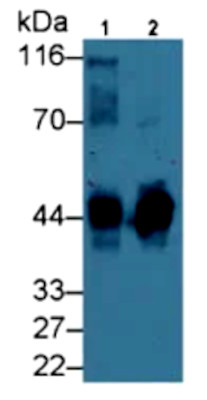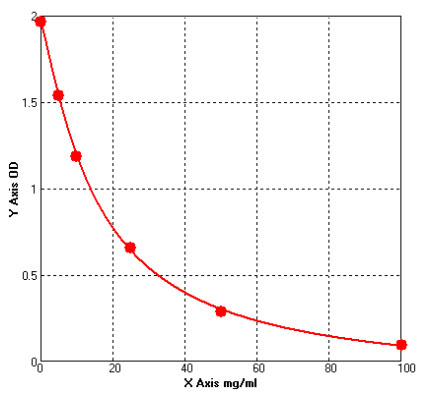Rabbit HSP90B Polyclonal Antibody | anti-HSP90B antibody
HSP90B Antibody
Phosphate buffered saline, pH 7.4, 150mM NaCl, 0.02% sodium azide and 50% glycerol.
IHC: 1:50-1:200
IF/ICC: 1:100-1:500
IHC (Immunohistchemistry)
(AAA31084 at 1/200 staining human liver cancer tissue sections by IHC-P. The tissue was formaldehyde fixed and a heat mediated antigen retrieval step in citrate buffer was performed. The tissue was then blocked and incubated with the antibody for 1.5 hours at 22 degree C. An HRP conjugated goat anti-rabbit antibody was used as the secondary.)
IHC (Immunohistochemistry)
(AAA31084 at 1/200 staining human liver cancer tissue sections by IHC-P. The tissue was formaldehyde fixed and a heat mediated antigen retrieval step in citrate buffer was performed. The tissue was then blocked and incubated with the antibody for 1.5 hours at 22 degree C. An HRP conjugated goat anti-rabbit antibody was used as the secondary.)
IHC (Immunohistochemistry)
(AAA31084 at 1/200 staining human liver cancer tissue sections by IHC-P. The tissue was formaldehyde fixed and a heat mediated antigen retrieval step in citrate buffer was performed. The tissue was then blocked and incubated with the antibody for 1.5 hours at 22 degree C. An HRP conjugated goat anti-rabbit antibody was used as the secondary.)
IF (Immunofluorescence)
(AAA31084 staining HeLa cells by IF/ICC. The sample were fixed with PFA and permeabilized in 0.1% Triton X-100, then blocked in 10% serum for 45 minutes at 25 degree C. The primary antibody was diluted at 1/200 and incubated with the sample for 1 hour at 37 degree C. An Alexa Fluor 594 conjugated goat anti-rabbit IgG (H+L) antibody, diluted at 1/600, was used as secondary antibody.)
WB (Western Blot)
(Western blot analysis of HSP90B expression in TNF-a treated HeLa whole cell lysates, The lane on the left is treated with the antigen-specific peptide.)
IHC (Immunohistochemistry)
(AAA31084 at 1/50 staining human liver cancer tissue sections by IHC-P. The tissue was formaldehyde fixed and a heat mediated antigen retrieval step in citrate buffer was performed. The tissue was then blocked and incubated with the antibody for 1.5 hours at 22 degree C. An HRP conjugated goat anti-rabbit antibody was used as the secondary.)
IHC (Immunohistochemistry)
(AAA31084 at 1/100 dilution staining HSP90B in human brain by Immunohistochemistry using paraffin-embedded tissue)
Subunit Structure: Monomer (PubMed:24880080). Homodimer (PubMed:7588731, PubMed:18400751). Forms a complex with CDK6 and CDC37 (PubMed:9482106, PubMed:25486457). Interacts with UNC45A; binding to UNC45A involves 2 UNC45A monomers per HSP90AB1 dimer (PubMed:16478993). Interacts with CHORDC1 (By similarity). Interacts with DNAJC7 (PubMed:18620420). Interacts with FKBP4 (PubMed:15159550). May interact with NWD1 (PubMed:24681825). Interacts with SGTA (PubMed:16580629). Interacts with HSF1 in an ATP-dependent manner. Interacts with MET; the interaction suppresses MET kinase activity. Interacts with ERBB2 in an ATP-dependent manner; the interaction suppresses ERBB2 kinase activity. Interacts with HIF1A, KEAP1 and RHOBTB2 (PubMed:26517842). Interacts with STUB1 and SMAD3 (PubMed:24613385). Interacts with XPO1 and AHSA1 (PubMed:22022502, PubMed:25486457). Interacts with BIRC2 (PubMed:25486457). Interacts with KCNQ4; promotes cell surface expression of KCNQ4 (PubMed:23431407). Interacts with BIRC2; prevents auto-ubiquitination and degradation of its client protein BIRC2 (PubMed:18239673). Interacts with NOS3 (PubMed:23585225). Interacts with AHR; interaction is inhibited by HSP90AB1 phosphorylation on Ser-226 and Ser-255 (PubMed:15581363). Interacts with STIP1 and CDC37; upon SMYD2-dependent methylation (PubMed:24880080). Interacts with JAK2 and PRKCE; promotes functional activation in a heat shock-dependent manner (PubMed:20353823). Interacts with HSP90AA1; interaction is constitutive (PubMed:20353823). HSP90AB1-CDC37 chaperone complex interacts with inactive MAPK7 (via N-terminal half) in resting cells; the interaction is MAP2K5-independent and prevents from ubiquitination and proteasomal degradation (PubMed:23428871). Interacts with CDC25A; prevents heat shock-mediated CDC25A degradation and contributes to cell cycle progression (PubMed:22843495). Interacts with TP53 (via DNA binding domain); suppresses TP53 aggregation and prevents from irreversible thermal inactivation (PubMed:15358771). Interacts with TGFB1 processed form (LAP); inhibits latent TGFB1 activation (PubMed:20599762). Interacts with TRIM8; prevents nucleus translocation of phosphorylated STAT3 and HSP90AB1 (By similarity).
Post-translational Modifications: Ubiquitinated in the presence of STUB1-UBE2D1 complex (in vitro). ISGylated. S-nitrosylated; negatively regulates the ATPase activity. Phosphorylation at Tyr-301 by SRC is induced by lipopolysaccharide (PubMed:23585225). Phosphorylation at Ser-226 and Ser-255 inhibits AHR interaction (PubMed:15581363). Methylated by SMYD2; facilitates dimerization and chaperone complex formation; promotes cancer cell proliferation. Cleaved following oxidative stress resulting in HSP90AB1 protein radicals formation; disrupts the chaperoning function and the degradation of its client proteins.
Similarity: The TPR repeat-binding motif mediates interaction with TPR repeat-containing proteins. Belongs to the heat shock protein 90 family.
NCBI and Uniprot Product Information
Predicted: 84 kDa
Similar Products
Product Notes
The HSP90B hsp90ab1 (Catalog #AAA31084) is an Antibody produced from Rabbit and is intended for research purposes only. The product is available for immediate purchase. The HSP90B Antibody reacts with Human, Mouse, Rat and may cross-react with other species as described in the data sheet. AAA Biotech's HSP90B can be used in a range of immunoassay formats including, but not limited to, Western Blot (WB), Immunohistochemisty (IHC), Immunoflurescene (IF), Immunocytochemistry (ICC), Immunoprecipitation (IP), ELISA (EIA). WB: 1:500-1:2000 IHC: 1:50-1:200 IF/ICC: 1:100-1:500. Researchers should empirically determine the suitability of the HSP90B hsp90ab1 for an application not listed in the data sheet. Researchers commonly develop new applications and it is an integral, important part of the investigative research process. It is sometimes possible for the material contained within the vial of "HSP90B, Polyclonal Antibody" to become dispersed throughout the inside of the vial, particularly around the seal of said vial, during shipment and storage. We always suggest centrifuging these vials to consolidate all of the liquid away from the lid and to the bottom of the vial prior to opening. Please be advised that certain products may require dry ice for shipping and that, if this is the case, an additional dry ice fee may also be required.Precautions
All products in the AAA Biotech catalog are strictly for research-use only, and are absolutely not suitable for use in any sort of medical, therapeutic, prophylactic, in-vivo, or diagnostic capacity. By purchasing a product from AAA Biotech, you are explicitly certifying that said products will be properly tested and used in line with industry standard. AAA Biotech and its authorized distribution partners reserve the right to refuse to fulfill any order if we have any indication that a purchaser may be intending to use a product outside of our accepted criteria.Disclaimer
Though we do strive to guarantee the information represented in this datasheet, AAA Biotech cannot be held responsible for any oversights or imprecisions. AAA Biotech reserves the right to adjust any aspect of this datasheet at any time and without notice. It is the responsibility of the customer to inform AAA Biotech of any product performance issues observed or experienced within 30 days of receipt of said product. To see additional details on this or any of our other policies, please see our Terms & Conditions page.Item has been added to Shopping Cart
If you are ready to order, navigate to Shopping Cart and get ready to checkout.



























